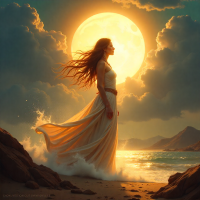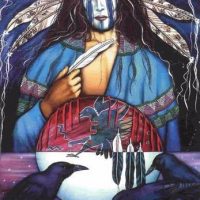Awonawilona : The Source of Life in Zuni Mythology
Listen
At a glance
| Description | |
|---|---|
| Origin | Zuni Mythology |
| Classification | Gods |
| Family Members | N/A |
| Region | United States of America |
| Associated With | Creation |
Awonawilona
Introduction
Awonawilona is the supreme creator deity in Zuni mythology, revered as the source of all life and the embodiment of the universe’s creative essence. Known as the “All Container,” Awonawilona encompasses everything that exists—light, air, water, and the spiritual forces that sustain the cosmos. Unlike most deities across global mythologies, Awonawilona transcends gender and physical form, representing the abstract, limitless power of creation itself. According to Zuni tradition, this deity emerged from a state of absolute nothingness, manifesting thought into reality by forming mist, clouds, and eventually the sun, which illuminated the world. Through this act of divine self-transformation, Awonawilona brought order, light, and life to the previously empty void, establishing the foundation of Zuni cosmology and spiritual understanding.
The myth of Awonawilona is not simply a story of origins; it reflects the Zuni people’s deep respect for the natural world and the interconnectedness of all existence. Every mountain, river, and living being is seen as a reflection of the deity’s creative energy. This worldview continues to shape Zuni culture, spirituality, and their harmonious relationship with nature even today.
Physical Traits
In Zuni mythology, Awonawilona is beyond human comprehension and physical limitation. Initially formless, the deity existed as pure creative energy, without shape, substance, or gender. This shapelessness symbolizes the unmanifest potential of existence before creation. When Awonawilona chose to become manifest, they transformed into the sun, bringing light to the cosmos and becoming the visible representation of their life-giving essence. The sun thus became the living symbol of the deity’s energy, radiating warmth, illumination, and fertility across the newly formed world.
Rather than appearing in a humanoid or animal form, Awonawilona is understood through the natural phenomena that emanate from their essence—light, air, mist, and flowing water. These elements collectively represent creation and sustenance, each carrying the deity’s presence. This abstract representation underlines an important aspect of Zuni belief: divinity exists not as a distant, personified god but as an ever-present, vital force within all creation.
Family
At the beginning of existence, Awonawilona stood alone, self-created and complete. Yet, from their creative actions, other divine beings came into existence, forming the structure of the Zuni pantheon. Two of the most significant beings to emerge were Apoyan Tachu, the All-Covering Father Sky, and Awitelin Tsita, the Four-Fold Containing Mother Earth. These deities arose from the mist and waters formed by Awonawilona, representing the dual principles of sky and earth that govern the physical and spiritual realms.
Together, Father Sky and Mother Earth became the parents of all life, nurturing the growth of plants, animals, and humans. Other divine entities, such as the Shiwani and Shiwonokia, emerged as guardians and intermediaries between the divine and mortal realms. While Awonawilona remains distinct and supreme above these beings, the creation of this divine family demonstrates the Zuni understanding of balance, cooperation, and cyclical relationships in nature. The origin of all life from Awonawilona reinforces the sacred unity of existence—a core tenet of Zuni cosmology.
Other names
Though “Awonawilona” is the most recognized form of the name, variations appear in oral traditions, sometimes rendered as A’wonawilona or Awonawi-lona, emphasizing the deity’s connection to breath, mist, and airflow. Translations such as “All Container,” “Supreme Life-Giver,” or “The Maker of All” are also used to describe the deity’s universal creative power. Each title reflects a different facet of the same divine principle—Awonawilona as both the origin and vessel of all creation.
Unlike many gods who bear multiple epithets signifying separate roles, Awonawilona’s name itself conveys totality and unity. It is both personal and cosmic, expressing the deity’s omnipresence and the idea that all existence resides within them. This linguistic simplicity mirrors the Zuni view that the divine is not fragmented but whole and self-contained.
Powers and Abilities
Awonawilona’s powers are absolute and cosmic in scope. The deity’s primary ability is creation ex nihilo—the power to bring everything into existence from nothing. Through the act of self-reflection and will, Awonawilona formed the essential elements of the universe: mist, water, air, and light. These elements merged and evolved into the physical and spiritual worlds inhabited by all beings.
When Awonawilona became the sun, their brilliance gave rise to life itself. The sun’s light warmed the waters, nourished the earth, and allowed plants and animals to flourish. From the green scum upon the waters—another manifestation of divine creation—emerged Father Sky and Mother Earth, the deities responsible for populating the world.
Awonawilona’s creative power extends beyond physical formation; they embody the principle of life that sustains all beings. Their essence flows through rivers, shines in sunlight, and moves in the air that sustains breath. Unlike mythological figures who perform heroic acts or wage divine wars, Awonawilona’s power is quiet yet omnipresent—expressed through the ongoing cycles of nature and the balance that keeps the cosmos in harmony. This portrayal presents the deity as both the creator and the sustaining force of the universe, reflecting a philosophy of continuity rather than dominance.
Modern Day Influence
Even in contemporary times, Awonawilona remains a central figure in Zuni spirituality and cultural identity. The mythology of Awonawilona is not confined to the distant past but continues to guide the Zuni people’s relationship with nature, community, and the cosmos. The deity’s teachings emphasize harmony, respect for life, and the interconnectedness of all beings—values that continue to resonate in Zuni rituals, ceremonies, and artistic traditions.
In Zuni ceremonial life, Awonawilona’s presence is invoked during seasonal rituals connected to rain, planting, and harvest cycles. The deity’s creative force is honored through dances, chants, and prayers seeking balance and prosperity for the community.
Artistic expression also plays a vital role in preserving Awonawilona’s legacy. Zuni artisans often depict solar symbols, spirals, and radiating designs in pottery, textiles, and jewelry, symbolizing the light and energy of the creator. These motifs are not merely decorative but serve as reminders of the divine essence within all things.
Awonawilona’s story also contributes significantly to academic and intercultural dialogue about indigenous belief systems. Scholars draw parallels between Awonawilona and other creator deities such as the Egyptian Atum, the Hindu Brahman, and the Norse Ymir—each representing the primordial unity from which the universe unfolds. Yet, Awonawilona stands apart in the emphasis on genderless creation and the concept of divinity as a living continuum of energy rather than an external, ruling god.
In a broader sense, Awonawilona’s mythology aligns with modern environmental philosophies that advocate for ecological balance and sustainability. The Zuni belief that everything originates from and exists within the “All Container” fosters a sense of responsibility toward preserving the natural world. Through the teachings of Awonawilona, ancient wisdom finds renewed relevance in today’s global efforts to live in harmony with the Earth.
Related Images
Source
Bunten, A. C. (2008). Native American myths and legends. Scholastic Inc.
Leeming, D. A. (2005). The Oxford companion to world mythology. Oxford University Press.
Mails, T. E. (1997). The Zuni: people of the middle place. Gibbs Smith.
Newcomb, S. T. (1956). The Zuni Indians. In Handbook of North American Indians (Vol. 9, pp. 419-432). Smithsonian Institution.
Opler, M. E. (1940). An analysis of the Pueblo mythological system. University of New Mexico Press.
Robertson, H. J. (1996). Pueblo gods and myths. University of Arizona Press.
Voth, H. R. (1902). Traditional Zuni lore. The Journal of American Folklore, 15(56), 151-177.
Zuni Creation Myth. (2024). In Encyclopedia of Mythology. Retrieved November 2025, from https://en.wikipedia.org/wiki/Awonawilona
Native Languages of the Americas. (n.d.). Zuni Legends, Myths, and Stories. https://www.native-languages.org/zuni-legends.htm
Beckman, T. (1998). Notes on the Zuni Origin Myth. Harvey Mudd College. https://pages.hmc.edu/beckman/western/zuni.htm
Cushing, F. H. (1883). Zuni Folk Tales. American Folklore Society.
Wright, B. (Ed.). (1988). Zuni Origin Myths: Interpretations of Frank Hamilton Cushing’s Work. University of New Mexico Press.
Gill, S. D., & Sullivan, I. F. (1992). Dictionary of Native American Mythology. Oxford University Press.
Frequently Asked Questions
Who is Awonawilona in Zuni mythology?
Awonawilona is the supreme creator deity in Zuni mythology, known as the “All Container.” They embody all aspects of creation—light, water, air, and life—bringing the universe into existence through thought and transformation.
What does the name Awonawilona mean?
The name Awonawilona translates to “All Container” or “Supreme Life-Giver,” symbolizing a deity who both contains and creates all forms of life and energy in the cosmos.
How did Awonawilona create the world?
According to Zuni belief, Awonawilona created the universe from nothing by manifesting mist, clouds, and the sun. This act brought light to darkness, giving rise to the earth, sky, and all living beings.
Is Awonawilona male or female?
Awonawilona is a genderless or androgynous being, representing the total unity of masculine and feminine forces. This transcendent nature highlights the deity’s existence beyond human categories.
What is the significance of Awonawilona today?
Awonawilona remains central to Zuni spirituality and cultural heritage, symbolizing harmony between nature, humanity, and the divine. The deity’s teachings inspire ecological awareness, artistic expression, and cultural preservation among the Zuni people.






